TOYOTA COROLLA HATCHBACK 2020 Warranties & Maintenance Guides (in English)
Manufacturer: TOYOTA, Model Year: 2020, Model line: COROLLA HATCHBACK, Model: TOYOTA COROLLA HATCHBACK 2020Pages: 260, PDF Size: 8.54 MB
Page 101 of 260
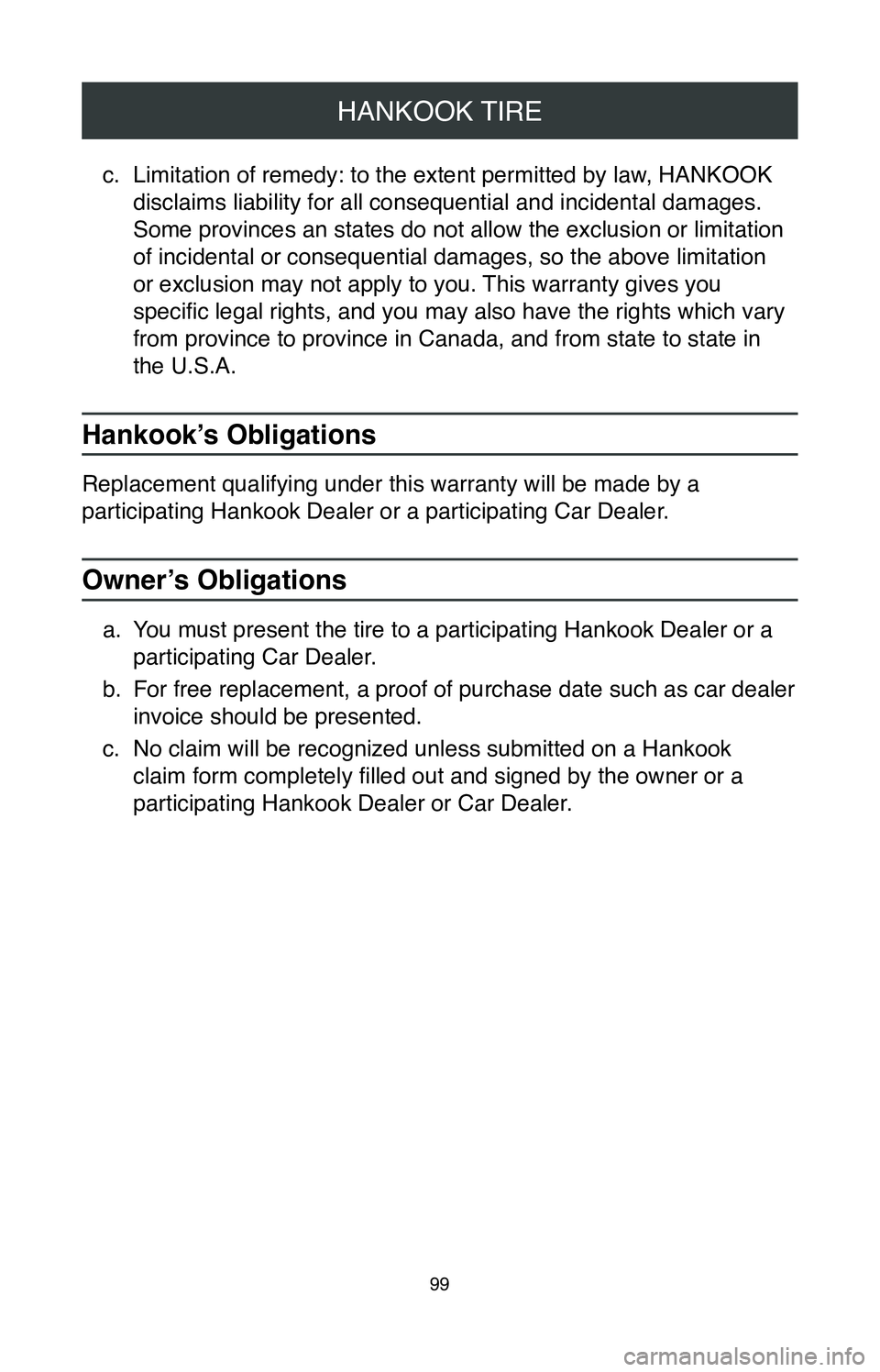
HANKOOK TIRE
99
c. Limitation of remedy: to the extent permitted by law, HANKOOK
disclaims liability for all consequential and incidental damages.
Some provinces an states do not allow the exclusion or limitation
of incidental or consequential damages, so the above limitation
or exclusion may not apply to you. This warranty gives you
specific legal rights, and you may also have the rights which vary
from province to province in Canada, and from state to state in
the U.S.A.
Hankook’s Obligations
Replacement qualifying under this warranty will be made by a
participating Hankook Dealer or a participating Car Dealer.
Owner’s Obligations
a. You must present the tire to a participating Hankook Dealer or a
participating Car Dealer.
b.
For free replacement, a proof of purchase date such as car dealer
invoice should be presented.
c.
No claim will be recognized unless submitted on a Hankook
claim form completely filled out and signed by the owner or a
participating Hankook Dealer or Car Dealer.
Page 102 of 260
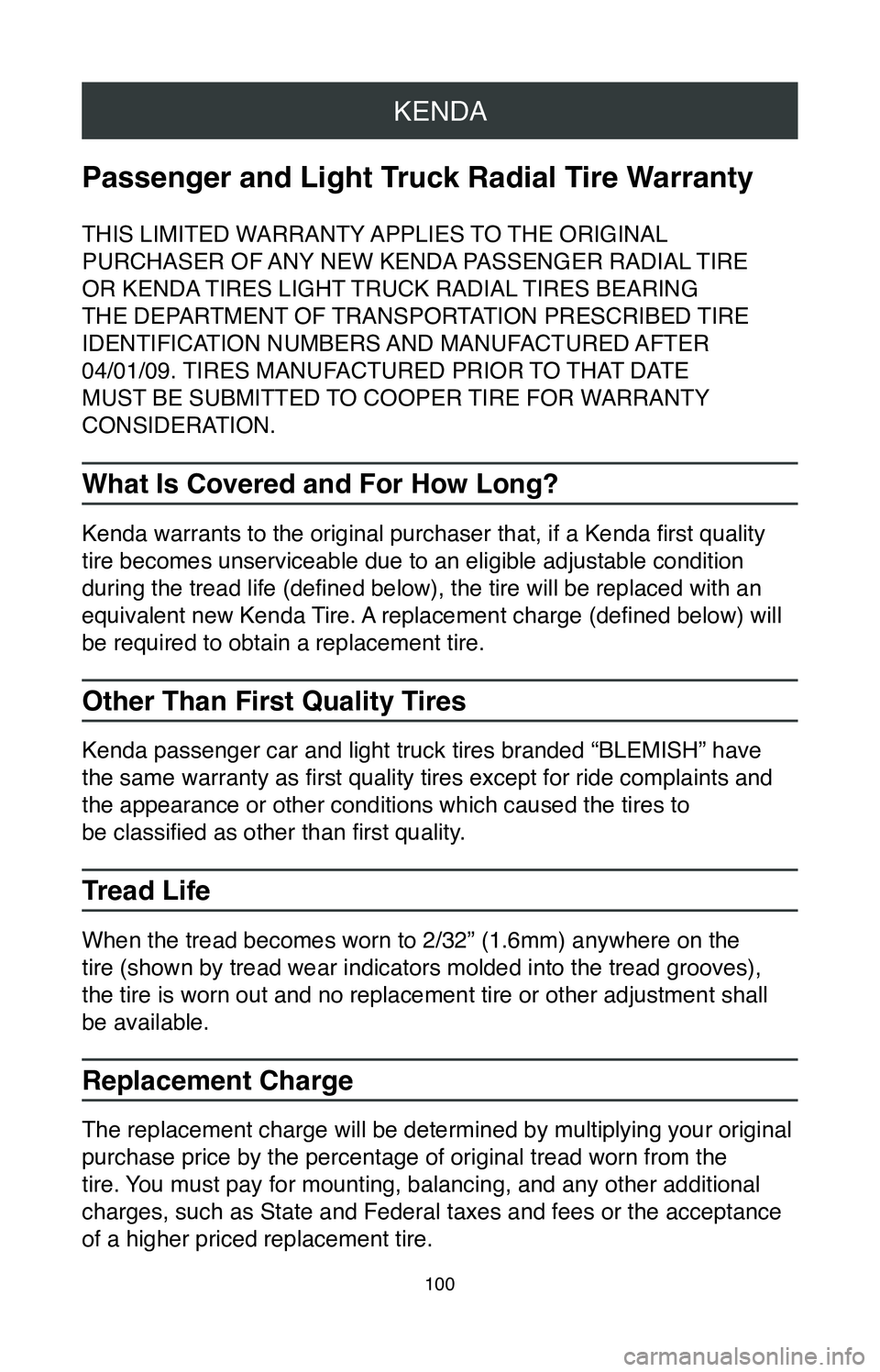
KENDA
100
Passenger and Light Truck Radial Tire Warranty
THIS LIMITED WARRANTY APPLIES TO THE ORIGINAL
PURCHASER OF ANY NEW KENDA PASSENGER RADIAL TIRE
OR KENDA TIRES LIGHT TRUCK RADIAL TIRES BEARING
THE DEPARTMENT OF TRANSPORTATION PRESCRIBED TIRE
IDENTIFICATION NUMBERS AND MANUFACTURED AFTER
04/01/09. TIRES MANUFACTURED PRIOR TO THAT DATE
MUST BE SUBMITTED TO COOPER TIRE FOR WARRANTY
CONSIDERATION.
What Is Covered and For How Long?
Kenda warrants to the original purchaser that, if a Kenda first quality
tire becomes unserviceable due to an eligible adjustable condition
during the tread life (defined below), the tire will be replaced with an
equivalent new Kenda Tire. A replacement charge (defined below) will
be required to obtain a replacement tire.
Other Than First Quality Tires
Kenda passenger car and light truck tires branded “BLEMISH” have
the same warranty as first quality tires except for ride complaints and
the appearance or other conditions which caused the tires to
be classified as other than first quality.
Tread Life
When the tread becomes worn to 2/32” (1.6mm) anywhere on the
tire (shown by tread wear indicators molded into the tread grooves),
the tire is worn out and no replacement tire or other adjustment shall
be available.
Replacement Charge
The replacement charge will be determined by multiplying your original
purchase price by the percentage of original tread worn from the
tire. You must pay for mounting, balancing, and any other additional
charges, such as State and Federal taxes and fees or the acceptance
of a higher priced replacement tire.
Page 103 of 260

KENDA
101
What Isn’t Covered
Adjustments will not be made for:A.
Tires that become unserviceable due to:
1.
Conditions resulting from road hazard such as (A) impact
damage, (B) cuts, (C) snags, or (D) punctures.
2.
Conditions resulting from (A) improper installation, (B) wheel
misalignment, (C) tire/wheel assembly imbalance, (D) use
on an improper rim (E) improper mounting or dismounting or
(F) misapplication.
3.
Conditions resulting from consumer damage, such as (A)
improper tire and vehicle maintenance, (D) misuse, abuse, (D)
accident, (E) under inflation, (F) overloading, (G) failure
to follow recommended rotation practices
4.
Ride complaints after the first 25% tread wear.
5.
Ride complaints on tires branded “Blemish”.
6.
Use in any commercial, racing, or off-road applications.
7.
Ozone or weather checking on tires over (4) four years from
date of manufacture.
8.
Continued use while being run flat or acute under-inflation.
9.
Tires stored improperly. or
B.
Tires that are:
1.
Worn unevenly and/or show a difference of 2/32” (1.6mm)
between the grooves.
2.
Installed on any vehicle other than the vehicle on which they
were first installed.
3.
Sold or adjusted outside the United States of America, the
District of Columbia and Canada
4.
Acquired as “used” tires.
5.
Altered in any manner (additional siping, buffing, stud pin
holes etc.)
6.
Worn to 2/32” (1.6mm) or more than 72 months old (based on
date of purchase) whichever occurs first.
7.
Improperly repaired or with repairs not conforming to the
Rubber Manufacturer’s Association standards.
Page 104 of 260
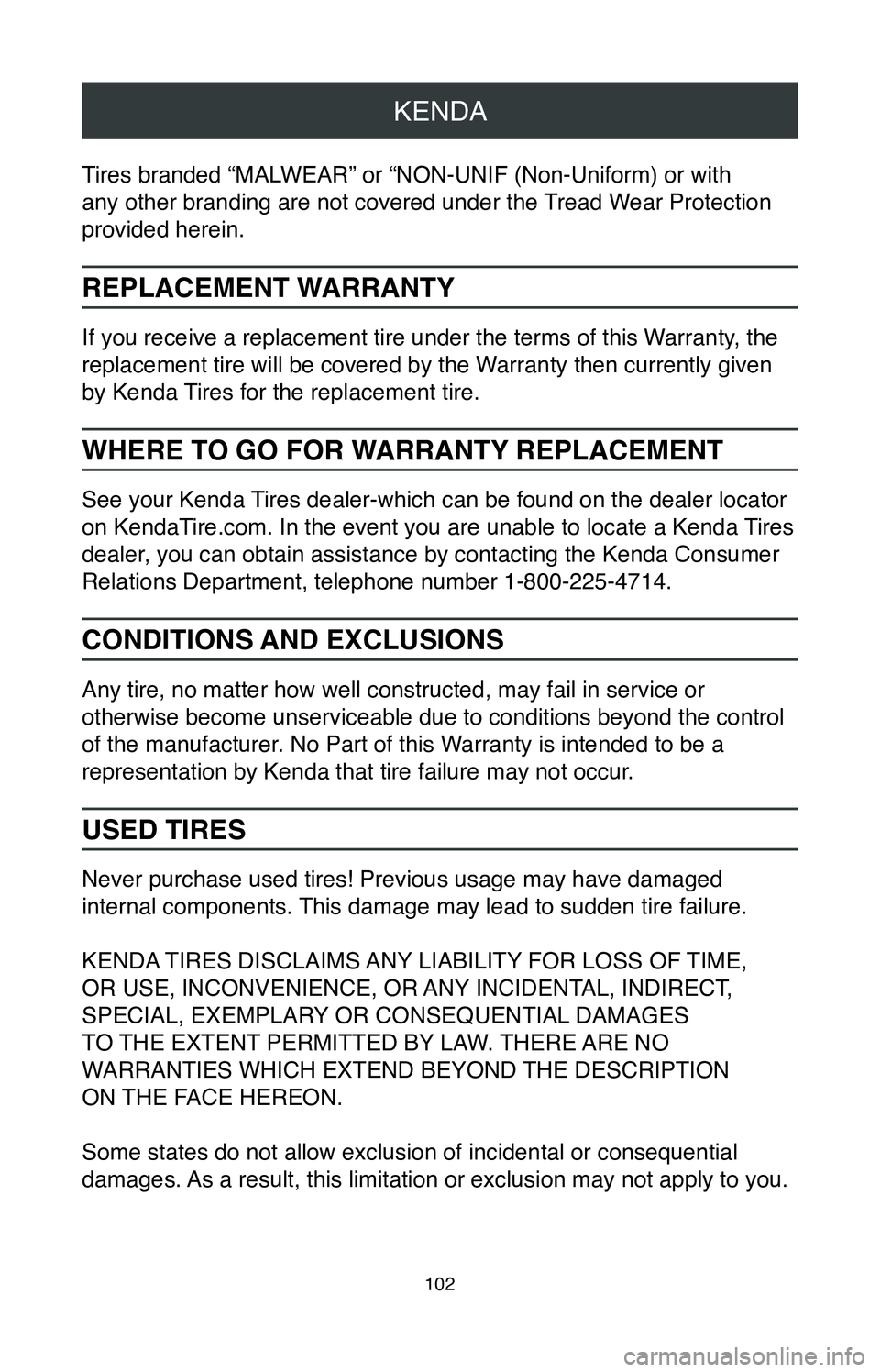
KENDA
102
Tires branded “MALWEAR” or “NON-UNIF (Non-Uniform) or with
any other branding are not covered under the Tread Wear Protection
provided herein.
REPLACEMENT WARRANTY
If you receive a replacement tire under the terms of this Warranty, the
replacement tire will be covered by the Warranty then currently given
by Kenda Tires for the replacement tire.
WHERE TO GO FOR WARRANTY REPLACEMENT
See your Kenda Tires dealer-which can be found on the dealer locator
on KendaTire.com. In the event you are unable to locate a Kenda Tires
dealer, you can obtain assistance by contacting the Kenda Consumer
Relations Department, telephone number 1-800-225-4714.
CONDITIONS AND EXCLUSIONS
Any tire, no matter how well constructed, may fail in service or
otherwise become unserviceable due to conditions beyond the control
of the manufacturer. No Part of this Warranty is intended to be a
representation by Kenda that tire failure may not occur.
USED TIRES
Never purchase used tires! Previous usage may have damaged
internal components. This damage may lead to sudden tire failure.
KENDA TIRES DISCLAIMS ANY LIABILITY FOR LOSS OF TIME,
OR USE, INCONVENIENCE, OR ANY INCIDENTAL, INDIRECT,
SPECIAL, EXEMPLARY OR CONSEQUENTIAL DAMAGES
TO THE EXTENT PERMITTED BY LAW. THERE ARE NO
WARRANTIES WHICH EXTEND BEYOND THE DESCRIPTION
ON THE FACE HEREON.
Some states do not allow exclusion of incidental or consequential
damages. As a result, this limitation or exclusion may not apply to you.
Page 105 of 260

KENDA
103
CONSUMER RIGHTS
This Warranty gives you specific legal rights, and you may also have
other rights that vary from state to state.
OWNER’S OBLIGATl0N
When making a claim, you must return the tire to be replaced to your
Kenda Tires dealer.
Proper vehicle and tire care is necessary to obtain the expected wear
from a tire. It is your obligation to properly maintain your tires and
the vehicle upon which they are mounted, including: (A) operating
your tires at the inflation pressures recommended by the vehicle
manufacturer, (B) keeping your tire/wheel assemblies in balance. (C)
proper wheel alignment, and (D) rotation. You must check your tire’s air
pressure at least monthly and before long trips.
We recommend that you have your Kenda Tires dealer inspect your
tires any time you notice irregular or uneven tread wear and rotate
them, if necessary. Also, they should be inspected by your dealer any
time your vehicle is brought in for service.
TREADWEAR LIMITED WARRANTY
For those qualifying brand tires listed in the product chart (see below),
Kenda Tires will provide prorated credit towards the purchase of a
comparable brand tire.
You will be responsible for the prorated cost of a replacement
tire, and also mounting and balancing costs, taxes and any
other charges.
The prorated cost of a replacement tire is determined as follows:
(Actual miles driven) ÷ (Amount of warranted miles) X (Actual current
dealer selling price)
Page 106 of 260
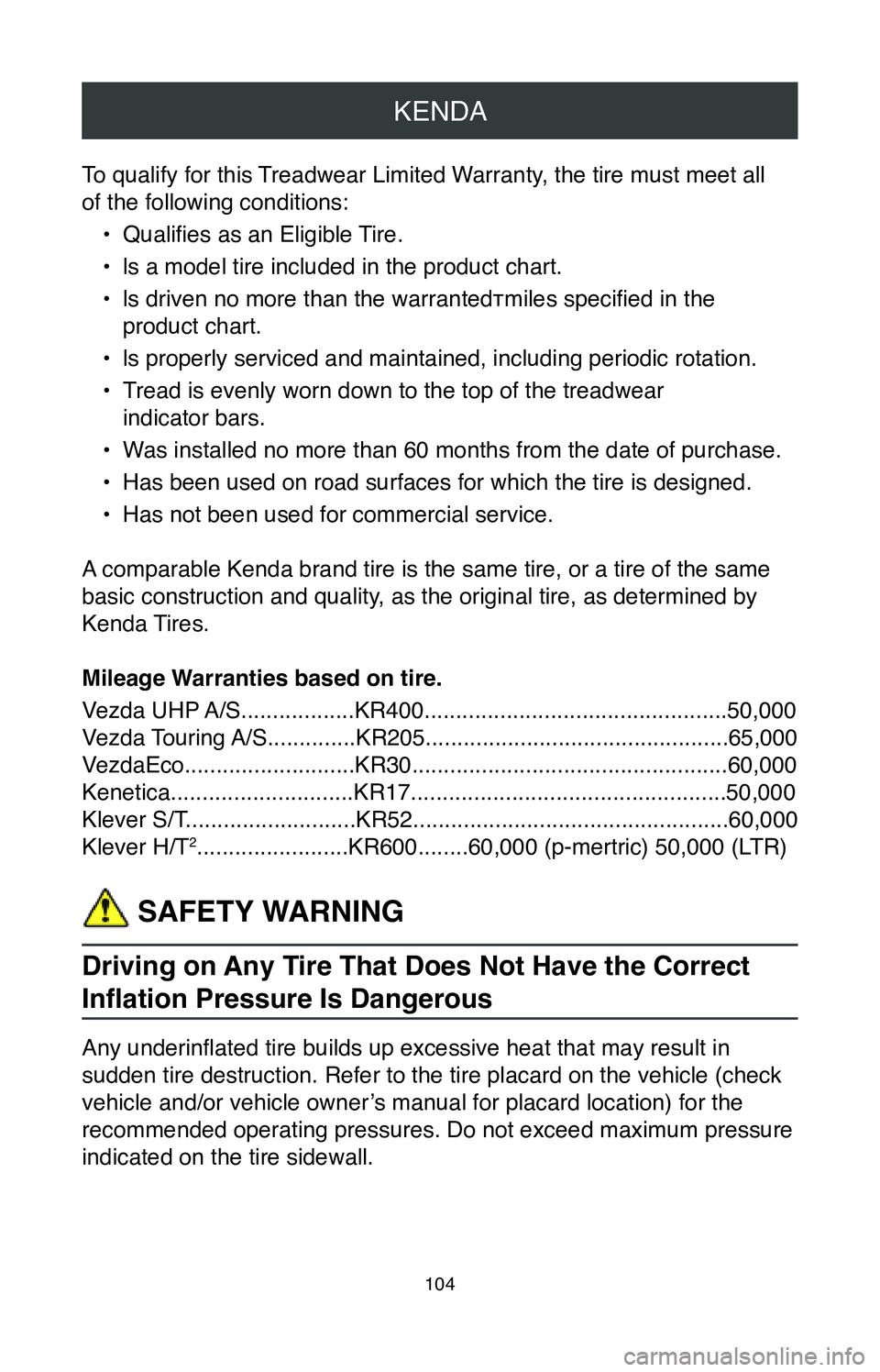
KENDA
104
To qualify for this Treadwear Limited Warranty, the tire must meet all
of the following conditions:•
Qualifies as an Eligible Tire.
•
ls a model tire included in the product chart.
•
ls driven no more than the warrantedтmiles specified in the
product chart.
•
ls properly serviced and maintained, including periodic rotation.
•
Tread is evenly worn down to the top of the treadwear
indicator bars.
•
Was installed no more than 60 months from the date of purchase.
•
Has been used on road surfaces for which the tire is designed.
•
Has not been used for commercial service.
A comparable Kenda brand tire is the same tire, or a tire of the same
basic construction and quality, as the original tire, as determined by
Kenda Tires.
Mileage Warranties based on tire.
Vezda UHP A/S..................KR400.............................................\
...50,000
Vezda Touring A/S..............KR205................................................65\
,000
VezdaEco...........................KR30..................................\
................60,000
Kenetica.............................KR17...............................\
...................50,000
Klever S/T...........................KR52.........................................\
.........60,000
Klever H/T
2........................KR600........60,000 (p-mertric) 50,000 (LTR)
SAFETY WARNING
Driving on Any Tire That Does Not Have the Correct
Inflation Pressure Is Dangerous
Any underinflated tire builds up excessive heat that may result in
sudden tire destruction. Refer to the tire placard on the vehicle (check
vehicle and/or vehicle owner’s manual for placard location) for the
recommended operating pressures. Do not exceed maximum pressure
indicated on the tire sidewall.
Page 107 of 260
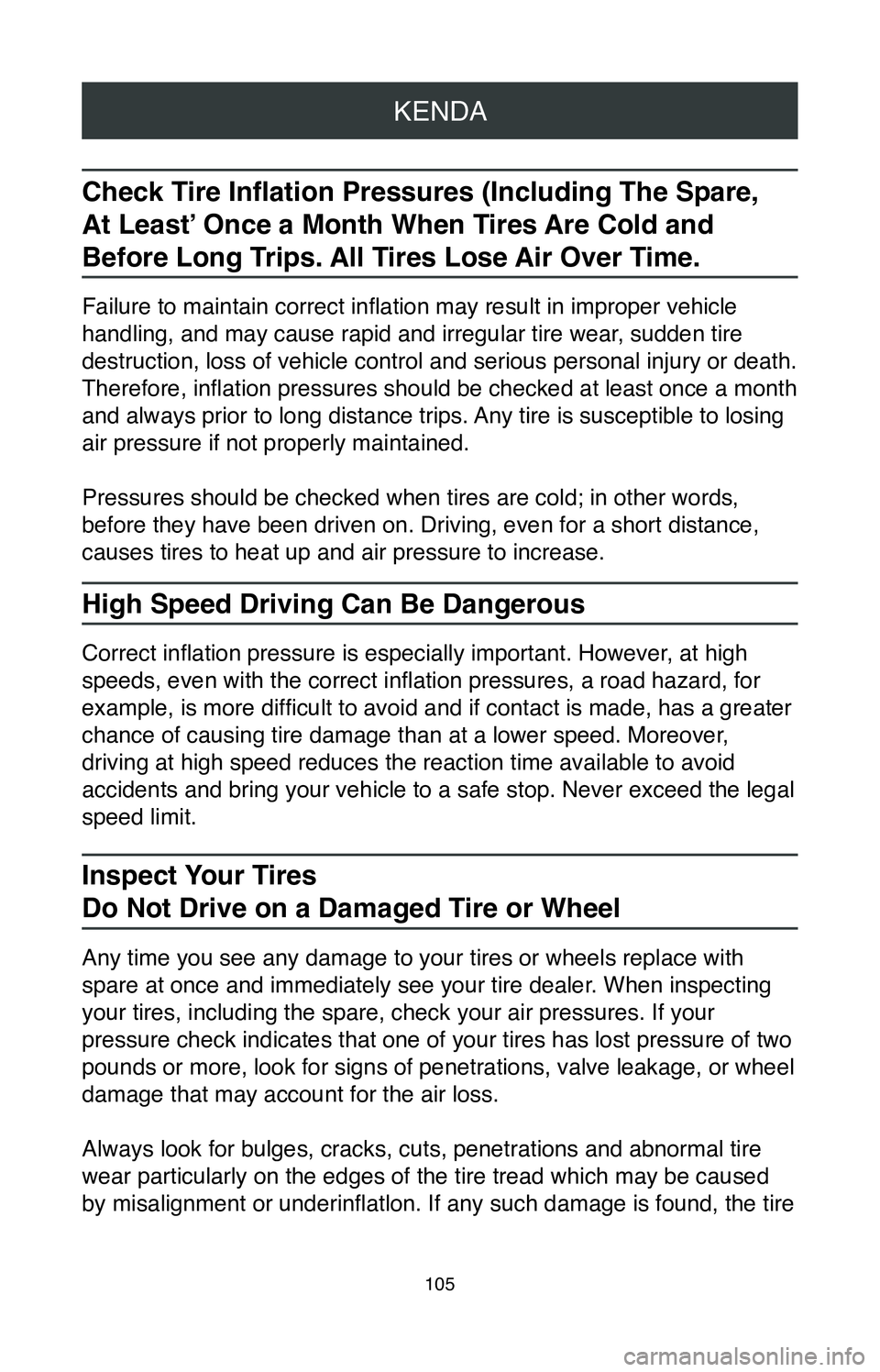
KENDA
105
Check Tire Inflation Pressures (Including The Spare,
At Least’ Once a Month When Tires Are Cold and
Before Long Trips. All Tires Lose Air Over Time.
Failure to maintain correct inflation may result in improper vehicle
handling, and may cause rapid and irregular tire wear, sudden tire
destruction, loss of vehicle control and serious personal injury or death.
Therefore, inflation pressures should be checked at least once a month
and always prior to long distance trips. Any tire is susceptible to losing
air pressure if not properly maintained.
Pressures should be checked when tires are cold; in other words,
before they have been driven on. Driving, even for a short distance,
causes tires to heat up and air pressure to increase.
High Speed Driving Can Be Dangerous
Correct inflation pressure is especially important. However, at high
speeds, even with the correct inflation pressures, a road hazard, for
example, is more difficult to avoid and if contact is made, has a greater
chance of causing tire damage than at a lower speed. Moreover,
driving at high speed reduces the reaction time available to avoid
accidents and bring your vehicle to a safe stop. Never exceed the legal \
speed limit.
Inspect Your Tires
Do Not Drive on a Damaged Tire or Wheel
Any time you see any damage to your tires or wheels replace with
spare at once and immediately see your tire dealer. When inspecting
your tires, including the spare, check your air pressures. If your
pressure check indicates that one of your tires has lost pressure of two\
pounds or more, look for signs of penetrations, valve leakage, or wheel \
damage that may account for the air loss.
Always look for bulges, cracks, cuts, penetrations and abnormal tire
wear particularly on the edges of the tire tread which may be caused
by misalignment or underinflatlon. If any such damage is found, the tire
Page 108 of 260

KENDA
106
must be inspected by any tire dealer at once. Use of a damaged tire
could result in sudden tire destruction.
All tires will wear out faster when subjected to high speeds as well as
hard cornering, rapid starts, sudden stops, frequent driving on roads
which are in poor condition, and off road use. Roads with holes and
rocks or other objects can damage tires and cause misalignment of
your vehicle. When you drive on such roads, drive on them carefully
and slowly, and before driving at normal or highway speeds, examine
your tires for any damage, such as cuts or penetrations.
Worn Out Tires Are Dangerous
Tires contain ‘Wear-Bars” in the grooves of the tire tread which show
up when only 2/32nds of an inch (1.6mm) tread is remaining. At this
stage, your tires must be replaced. Tires worn beyond this stage
are dangerous.
Do Not Overload
Driving On Any Overloaded Tire Is Dangerous
The maximum load rating of your tires is marked on the tire sidewall.
Do not exceed these ratings. Follow the loading instructions of the
manufacturer of your vehicle and this will insure that your tires are no\
t
overloaded. Tires which are loaded beyond their maximum allowable
loads for the particular application will build up excessive heat that m\
ay
result in sudden tire destruction.
Do not exceed the gross axle weight ratings for any axle on your
vehicle. TRAILER TOWING
If you anticipate towing a trailer, you should see any tire dealer for
advice concerning the correct size of tire and pressures. Tire size
and pressures will depend upon the type and size of trailer and hitch
utilized, but in no case must the maximum cold inflation pressure of
tire load rating be exceeded. Check the tire placard and the owner’s
manual supplied by the manufacturer of your vehicle for further
recommendations on trailer towing.
Page 109 of 260

KENDA
107
Wheel Alignment and Balancing Are Important for
Safety and Maximum Mileage From Your Tires
Inspect Your Tires Regularly
At least once a month inspect your tires closely for signs of uneven
wear. Uneven wear patterns may be caused by improper inflation
pressures, misalignment, improper balance or suspension neglect.
If not corrected, further tire damage will occur. These conditions not
only shorten the life of your tires, they adversely affect the handling
characteristics of your vehicle which could be dangerous.
If any of these conditions exist, the cause may often be corrected at
your tire dealer’s or other service facility. Your tires will then last longer.
Tire Rotation
If irregular wear becomes apparent or if the rate of wear on the tires
is uneven, the tires should be rotated to alleviate the problem. Check
your vehicle for any mechanical problems and correct if necessary. The
rotation pattern or procedure indicated in your limited warranty and the\
vehicle manufacturers’ owner’s manual should be followed. For tires
on front wheel drive vehicles and/or all season tires on any vehicle, it\
is
recommended that these tires be rotated every 8,000 miles to equalize
the rate of wear.
Tire Mixing Can Be Dangerous
Most passenger tires today are radial tires and for best performance it \
is recommended that the same size and type of tire be used on all four
wheel positions unless different sizes, front and rear, were specified
as original equipment. Check the vehicle placard. If only two radials
are mounted with two non-radials, the radials should be mounted
on the rear. If tires of different types are mixed on a vehicle in any
configuration, they should not be used for long periods and speeds
should be kept to a minimum.
Mixing or matching of tires on 4-wheel drive vehicles may require
special precautions. Always check vehicle manufacturers’ Owner’s
Manual for their recommendations.
Page 110 of 260

KENDA
108
Tire Alterations Are Dangerous
Do not perform any alteration on your tires. Alterations may prevent
proper performance, leading to tire damage, which can result in
sudden tire destruction. Tires which have been altered are excluded
from warranty coverage.
Repairs. See Any Tire Dealer At Once
If any tire has sustained a puncture, have the tire dismounted and
inspected internally by any tire dealer for possible damage that may
have occurred.
Punctures in the tread of passenger tires which do not exceed 1/4-inch
(6mm) in diameter can be repaired by following Rubber Manufacturers’
Association (RMA) recommended repair procedures. Do not use
externally applied plug repairs. Punctures outside the tread area
should not be repaired.
If the tire has a puncture in the tread which exceeds 1/4-inch (6mm) or
if more than one radial cable per casing ply is damaged, the tire must
be replaced.
Storage
Tires should be stored in a cool dry place indoors so that there is no
danger of water collecting inside them. Serious problems occur with
tube type tires when they are mounted with water trapped between the
tire and the tube. Due to pressurization, the liquid can pass through
the inner liner and into the casing plies. This can result in sudden lire
failure. Most of the problems of this nature, encountered with tube type\
tires, have been due to improper storage which permitted water to
enter the casing between the tire and tube prior to mounting.
When tires are stored they should be stored in a cool place away from
sources of heat and ozone such as hot pipes and electric motors. Be
sure that surfaces of which tires are stored are clean and free from
grease, gasoline or other substances which could deteriorate the
rubber. Tires exposed to these materials and/or excessive heat for a